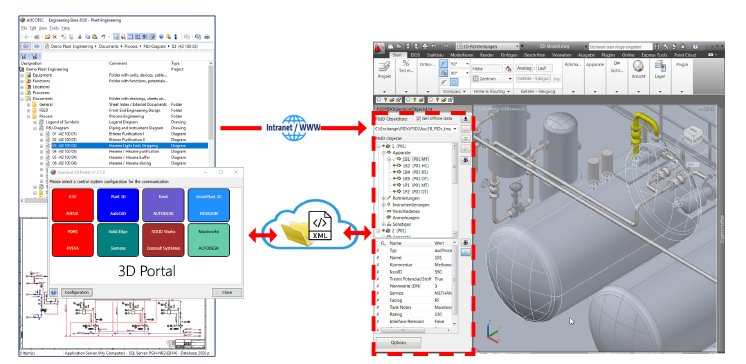The third dimension is always important in engineering when the optimal utilization of the given area or its adaptation is involved. Whether in large halls or in the cabinet: the tangible, physical route of pipes, cable trays or individual wires must be exactly calculated and reliably documented for manufacturing. However, the associated connections can be found in EB's 2-D design. In order to achieve continuous consistency, Aucotec has already implemented 3-D connections for numerous customers. There are now two innovations that simplify the connection and speed up the exchange.
Fits any 3-D system
The first innovation is EB's own standardized link which simplifies 3-D integration. This new "gateway" to the 3-D data allows the export of 2-D information to the 3-D system and the import of relevant 3-D data to EB via a tailored XML file. It is flexibly adaptable and can thus work with all common tools. Different templates can be defined because each 3-D system needs different information. The basic XML structure always remains the same.
XML-enabled plug-in
The 3-D side requires only one plug-in that can read XML. The neutral XML basis requires significantly less installation effort, and the plug-in is easier to maintain than traditional interfaces. 2-D and 3-D only have to agree on the same XML structure for the reading and writing of information to work and be comprehensible to both disciplines.
Web service facilitates independence
The second innovation is the web service for data exchange. Normally, an engineering system must be started in order to access its data. The 3-D portal is one of the first microservices in EB, which means that it works in a client-independent manner via the web. The special 3-D service is like an extra layer in EB's architecture via which you can obtain data at any time – with the appropriate rights, of course. This is as much of interest for globally distributed disciplines as it is for internal networks. Waiting times for the specialist "at the other end" are passé. Thus, the 3-D portal not only opens the door (gateway) to mutual "understanding" of the second and third engineering dimensions, but also to greater flexibility and efficiency in plant design.


